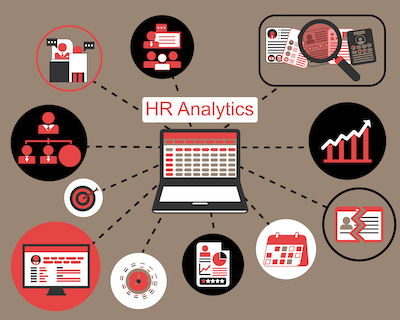By Caitlin Porter
Now more than ever, HR professionals are called upon to inform and support the strategic direction of businesses. The HR function is well-suited to this role. HR professionals consult with and support every aspect of the business, gaining insight into priorities, challenges, and opportunities. Moreover, HR professionals must stay abreast of legal and labor market dynamics. Thus, HR professionals glean information from a variety of sources, both within and outside of the organization, that enable them to identify pressing business challenges and recommend solutions. Although this situation offers abundant opportunity, it also represents a particularly challenging task: To critically evaluate information from a variety of sources and make decisions or recommendations based upon the best evidence available.
This evidence comes from a variety of sources, one of which is organizational data. Although HR professionals regularly calculate HR metrics based upon organizational data, compared to other business functions (i.e., finance, marketing, sales), HR has been relatively “late to the game” when it comes to leveraging data to inform business practices. However, HR is beginning to rely more heavily on HR analytics to create legitimacy, provide evidence to support recommendations, and illustrate the impact of HR on stakeholders.
In their 2017 article, Marler and Boudreau characterize HR analytics as an “HR practice enabled by information technology that uses descriptive, visual, and statistical analyses of data related to HR processes, human capital, organizational performance, and external economic benchmarks to establish business impact and enable data-driven decision-making.” In other words, HR Analytics involves using information technology (e.g., HR Information Systems) to collect, manage, and analyze data from sources outside the business and/or across business functions to support people-related decisions.
Yet, how should HR professionals go about leveraging HR analytics?
Below is an overview of the process by which practitioners can approach the gathering and analysis of information to arrive at potential business solutions.
- Observe and Question
The first step to leveraging HR analytics is defining the problem that needs a solution. For instance, a pressing concern for many organizations during the “Great Resignation” is employee retention. Not only can employee turnover cost the organization up to 200% of the leaver’s salary, but it also creates disruptions for remaining employees and customers.
Alternatively, business leaders may be curious about the effectiveness of HR programs and practices, such as whether an internal awards program improves retention of high performers, or whether a tuition reimbursement program facilitates employee career advancement.
- Gather Evidence
Once the “problem” has been identified, the next step is to gather relevant evidence. Because the problem or question you are facing is probably not wholly new or unique to your organization, you can gain insight from four sources.
First, to better understand the problem and its impact on the business, it is valuable to understand the concerns and values of relevant stakeholders, whether they be managers, employees, customers, vendors, or members of your community. These stakeholders can better define and contextualize the problem and give insight into potential reasons the problem exists as well as solutions.
Second, you can look to the scientific literature for theory and prior research to help you better understand your issue. Universities, consultancies, and non-profits employ organizational researchers who investigate organizations, HR practices, and employees. They often disseminate their research through white papers, blog posts, and other publications.
Third, you may turn to professionals with experience dealing with similar issues within your organization or professional network. Such professionals may have specialized knowledge about relevant employment law, ethical codes of conduct, the culture of the organization, or professional experiences that provide insights into what is appropriate and most likely to succeed within the legal, organizational, or industrial context.
Finally, you may turn to organizational data, such as interviews with stakeholders or HR metrics, to gain insight into what has been happening within the organization.
Before or while you gather this initial evidence, it may be useful to build your HR analytics team. You may turn to those with specialized knowledge within your organization, university professors, or management consultants, depending upon the nature of the problem and your bandwidth and budget.
- Develop a Hypothesis
Based on your initial research, you may identify one or more explanations for the problem or question, which are the basis of your hypothesis. A hypothesis is a statement of your educated guess that serves to guide your investigation.
An example hypothesis related to employee turnover is: If employees have more workplace friends, then they are less likely to voluntarily leave.
- Design Research Study and Collect Data
Your research question will inform your study design (experimental versus observational) and whether you collect qualitative data (nonnumeric text, such as interviews or open-ended questions) or quantitative data (numeric).
At this stage, it is valuable to have the right team in place, as several competencies are needed to conduct high-quality research, including knowledge of the business, research design, and measurement. You may have organizational psychologists on staff, or you may reach out to university professors or management consultants, who can provide direction.
As you plan your study, you need to determine whether your organization has already collected some relevant data. Indeed, most organizations track employee data using an HRIS and Key Performance Indicators in Enterprise Resource Software. Thus, one task may be to identify existing data sources, and who can help you access them, to determine if and which data is appropriate for your purposes.
Often, HR Analytics involves linking different data sources. For instance, a staff organizational psychologist may develop an employee engagement survey; and the responses to the engagement survey may be linked with turnover reasons stored in the HRIS. Throughout this process, it is important to acquire, manipulate, and store data in a way that enables subsequent analysis and maintains data privacy and security.
- Analyze Data and Interpret Results
Once data have been collected and managed, the next step is to conduct data analysis to test your hypothesis. Again, having the right team in place is essential. Staff organizational psychologists often have the expertise to determine the analytic approach for examining the hypothesis and to conduct advanced statistical analyses, but you may also have statisticians and/or data scientists on staff. Moreover, university professors and consultants also hold expertise in this area.
In addition, a member of the team needs to be knowledgeable enough about statistics and data analysis to communicate with the data analyst and knowledgeable enough about the business to communicate with managers. This person is valuable for translating the questions of managers to data analysts, and the challenges, limitations, and findings of the data analysis to managers, which creates clear lines of communication between the HR analytics team and stakeholders.
- Communicate Results
Finally, a member of the research team needs to communicate the results to the relevant stakeholders. To do so effectively, it is better to “tell a story with the results”. It is not necessary to report every finding; rather, it is better to identify the key findings, those that directly address the original research question or problem.
In addition, this is an opportunity for HR professionals to leverage their business acumen, consulting, and HR knowledge competencies. Rather than simply reporting relevant findings, HR professionals can make recommendations and advocate for directing resources towards supporting our stakeholders and fulfilling strategic goals. In this way, HR Analytics is a means to elevate HRM to a more strategic role.

caitlin.porter@memphis.edu
Assistant Professor
Department of Management
University of Memphis
